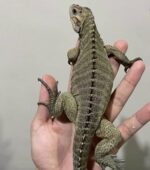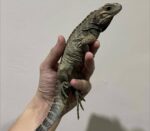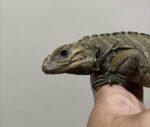Description
The rhinoceros iguana for sale (Cyclura cornuta) is an endangered species of iguana that is endemic to the Caribbean island of Hispaniola (shared by Haiti and the Dominican Republic) and its surrounding islands. A large lizard, they vary in length from 60 to 136 centimetres (24 to 54 in), and skin colours range from a steely grey to a dark green and even brown.
Their name derives from the bony-plated pseudo-horn or outgrowth which resembles the horn of a rhinoceros on the iguana’s snout. It is known to coexist with the Ricord’s iguana (C. ricordii); the two species are the only taxa of rock iguana to do so.
Taxonomy of Rhinoceros Iguana For Sale
The Rhinoceros Iguana For Sale is a species of lizard belonging to the genus Cyclura. The rhinoceros iguana’s specific name, cornuta, is the feminine form of the Latin adjective cornutus, meaning “horned” and refers to the horned projections on the snouts of males of the species. The species was first identified by Pierre Joseph Bonnaterre in 1789.
In addition to the nominate race (C. c. cornuta) found on Hispaniola, the other subspecies is the extinct Navassa Island iguana (C. c. onchiopsis). The Mona ground iguana (Cyclura stejnegeri) from Puerto Rico was originally thought to be a subspecies (and still is by some taxonomists), as Cyclura cornuta stejnegeri.
Anatomy and morphology of Rhinoceros Iguana For Sale
The rhinoceros iguana for sale, like other members of the genus Cyclura, is a large-bodied, heavy-headed lizard with strong legs and a vertically flattened tail. A crest of pointed horned scales extends from the nape of their neck to the tip of their tail. Their color is a uniform gray to brown drab.
Most adults weigh 4.56 to 9 kilograms (10.1 to 19.8 lb). Like all reptiles, rhinoceros iguanas are cold-blooded, meaning they need external sources to heat themselves; they move as the sun shifts in order to get an optimal internal temperature.
These iguanas are characterized by the growth of bony prominent tubercles on their snouts which resemble horns. Males possess an adipose pad in the form of a helmet on the occipital region of the head, and a large dewlap. This species, like other species of Cyclura, is sexually dimorphic; males are larger than females, and have more prominent dorsal crests and “horns” in addition to large femoral pores on their thighs, which are used to release pheromones.
Distribution and habitat Rhinoceros Iguana For Sale

Ranging in scattered locations throughout Hispaniola (in both Haiti and the Dominican Republic), populations are stable only on Isla Beata and the extreme of the Barahona Peninsula, inside Jaragua National Park.
There are moderately dense populations in the southeastern region of Haiti and its offshore islands, including the brackish lake of Étang Saumâtre, as well as the Dominican hypersaline Lake Enriquillo and its lake island, Isla Cabritos. Populations in Haiti are even more endangered due to deforestation, poaching for bushmeat, and human clearing practices.
Though not restricted to one single habitat, the iguanas are found most abundantly in scrub woodlands of the Hispaniolan dry forests (characterized by xeric, rocky terrain of eroded limestone with minimal flora), coastal terraces, lowlands of the mainland, plus several offshore islands and small cays, all with slightly different habitat types.
The favored biome of the Rhinoceros Iguana For Sale to live within is one that receives very little rain and has few trees or shrubs. True to the name “rock” iguana, they favor rather barren landscapes with smooth, large boulder formations and rocky outcrops for basking on, with adequate crevices and sheltered areas for retreating into. They will immediately flee into the rocks and crevasses to hide from predators such as humans, birds of prey, feral dogs and cats.























Reviews
There are no reviews yet.